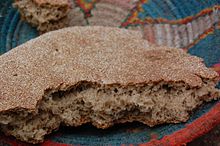Barley flour

Barley flour is a flour prepared from dried and ground barley.[1] Barley flour is used to prepare barley bread and other breads, such as flat bread and yeast breads.[1][2]
There are two general types of barley flour: coarse and fine.[3] Barley groats are milled to make coarse barley flour, and pearl barley is milled to make fine barley flour.[3]
Additionally, patent barley flour is a finer barley flour that is ground to a greater degree compared to fine barley flour.
Uses
[edit]Barley flour is used to prepare breads such as barley bread.[4][5] It is sometimes added to wheat flour, creating a composite flour, which is used to prepare various breads.[2] Its addition to wheat flour creates a darker-colored baked end-product, and also alters the flavor of the product.[1][2] Barley flour is also used as an ingredient in some specialty foods.[2]
Barley breading[clarification needed] is another food product[further explanation needed] prepared using barley flour, which can be prepared using pregelatinized barley flour and an additional product called barley crunch, similar to Grape-Nuts cereal.[2]
-
A basic barley bread
-
Barley breads prepared using highland barley in Songpan County, Sichuan province, China
Malted barley flour
[edit]
Malted barley flour is prepared from barley malt,[2] which is barley that has undergone malting (partial germination [sprouting] followed by hot-air drying to stop germination). There are two kinds, diastatic and non-diastatic. Diastatic malt flour is used as a diastatic supplement for other bread flours that have low natural diastatic activity.[2] Diastatic activity involves the conversion of starches into maltose (sugar).[6][7] In baking, adding malted barley flour to wheat flour results in a moister product than would wheat flour alone.[8] Malted barley flour that is rich in protein content is typically used in the food industry, while that which is poor in protein content is typically used to prepare a unique style of beer.[2] While distatic malted barley flour is taste neutral, the non-distatic kind, sometimes referred to as malt flour, is used for its distinctive flavor. It has many uses, such as malted milk, and in baked goods, to give them a softer crumb, and to supplement the flavor of a malt loaf.[2]
Patent barley flour
[edit]Patent barley flour is a finer flour that is ground to a greater degree compared to fine barley flour.[9] It is prepared from milling barley that has its outer layers removed to a greater degree compared to pearl barley.[9] Patent barley flour is used as an ingredient in infant foods.[2][9]
See also
[edit]- Chalboribbang – Korean pancakes prepared using glutinous barley flour
- Flatbrød – a Norwegian bread prepared using barley flour, water and salt
- Raspeball – a Norwegian food made with Barley flour and Potatoes. often served with mashed Rutabaga, carrots, melted butter, bacon and meat
- Máchica – a flour made from ground toasted barley or other toasted grains
- Pinda – a rice ball of Hindu origin prepared using barley flour, ghee and black sesame seeds
- Pitepalt – prepared with barley flour and raw potatoes as primary ingredients
- Tsampa – a roasted flour prepared using barley flour, and sometimes wheat flour
References
[edit]- ^ a b c Newman, R.K.; Newman, C.W. (2008). Barley for Food and Health: Science, Technology, and Products. Wiley. pp. 150–. ISBN 978-0-470-37122-0. Retrieved May 30, 2016. (subscription required)
- ^ a b c d e f g h i j Kent, N.L.; Evers, A.D. (1994). Technology of Cereals: An Introduction for Students of Food Science and Agriculture. Pergamon. p. 181. ISBN 978-0-08-040834-7. Retrieved May 30, 2016.
- ^ a b Ensminger, M.E.; Ensminger, A.H. (1993). Foods & Nutrition Encyclopedia, Two Volume Set. Taylor & Francis. p. 164. ISBN 978-0-8493-8980-1. Retrieved May 30, 2016.
- ^ Hensperger, B. (2000). Bread Lover's Bread Machine Cookbook: A Master Baker's 300 Favorite Recipes for Perfect-Every-Time Bread-From Every Kind of Machine. Harvard Common Press. p. 171. ISBN 978-1-55832-156-4. Retrieved May 30, 2016.
- ^ Alcock, J.P. (2006). Food in the Ancient World. Food through history. Greenwood Press. p. 33. ISBN 978-0-313-33003-2. Retrieved May 30, 2016.
- ^ Mycological Series - Bulletin. 1909. p. 31. Retrieved May 30, 2016.
- ^ "definition of diastatic". Merriam-Webster. Retrieved 30 May 2016.
- ^ Oulton, Randal (15 June 2005). "Malted Barley Flour". CooksInfo.com. Archived from the original on 10 October 2017. Retrieved 10 October 2017.
What it does do is give a moister crumb ... It is used commercially a great deal in bread, pizza crusts, crackers, rolls, pretzels etc as a dough conditioner—because of its lower gluten, it causes the dough to be softer, more relaxed and gives a softer crumb texture.
- ^ a b c Sherman, H.C. (1914). Food Products. Macmillan. pp. 252–253. Retrieved May 30, 2016.
External links
[edit] Media related to Barley flour at Wikimedia Commons
Media related to Barley flour at Wikimedia Commons


